Family: Siricidae
Subfamily: Siricinae
Genus: Sirex Linnaeus, 1760
Species: Sirex abietinus Goulet, 2012
Common names: none
Sirex abietinus is a western NearcticNearctic:
describing the region of the Northern Hemisphere that includes North America south through northern Mexico
 species with a typical metallic blue-black coloration and mostly light-colored legs (Schiff et al. 2012Schiff et al. 2012:
species with a typical metallic blue-black coloration and mostly light-colored legs (Schiff et al. 2012Schiff et al. 2012:
Schiff NM, Goulet H, Smith DR, Boudreault C, Wilson AD, and Scheffler BE. 2012. Siricidae (Hymenoptera: Symphyta: Siricoidea) of the Western Hemisphere. Canadian Journal of Arthropod Identification 21: 1-305.).
See Sirex for genus-level diagnostic characteristics.
Females:
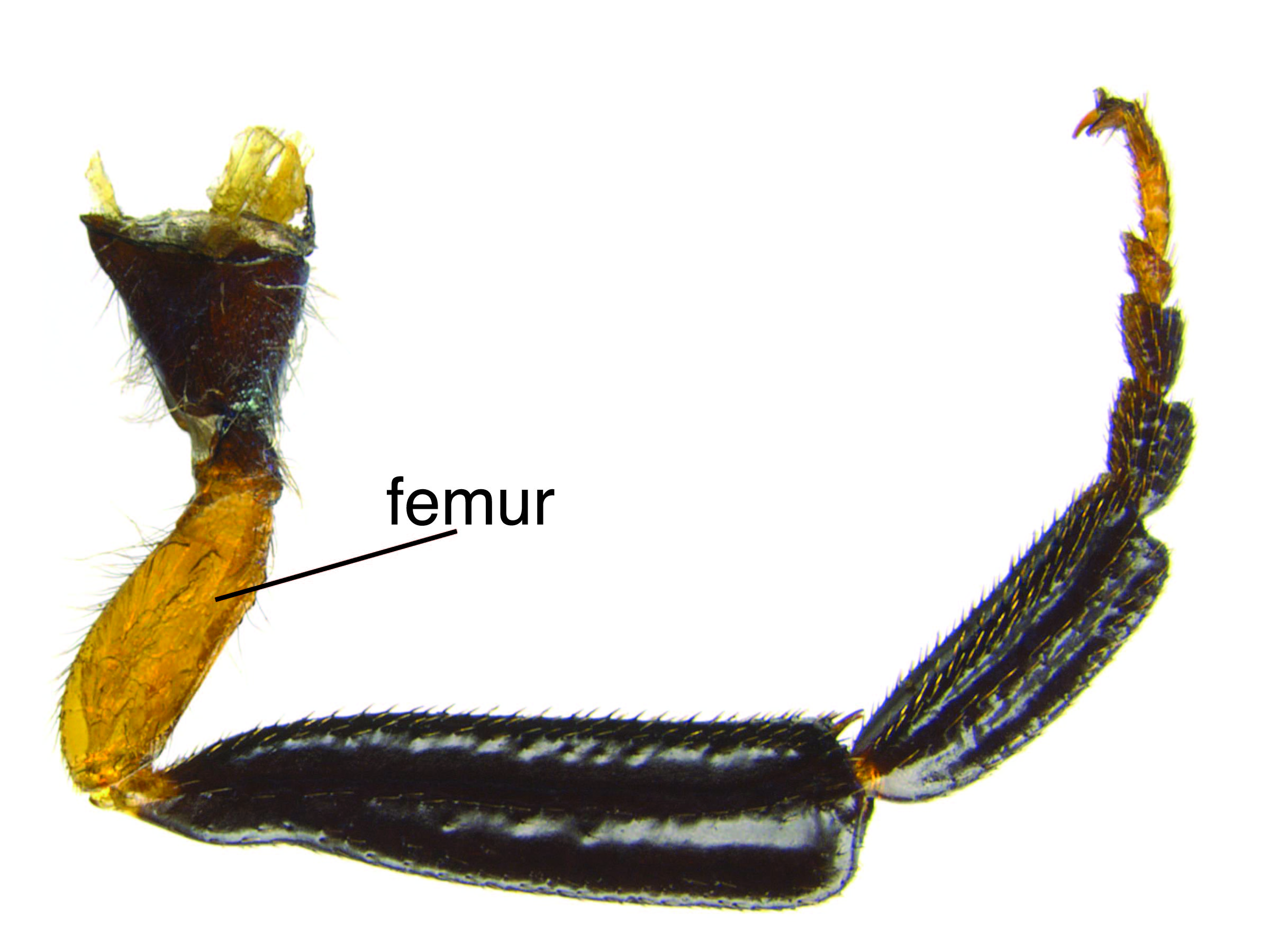 light reddish-brown (Schiff et al. 2012Schiff et al. 2012:
light reddish-brown (Schiff et al. 2012Schiff et al. 2012: metallic blue-black (Schiff et al. 2012Schiff et al. 2012:
metallic blue-black (Schiff et al. 2012Schiff et al. 2012: light reddish-brown (Schiff et al. 2012Schiff et al. 2012:
light reddish-brown (Schiff et al. 2012Schiff et al. 2012: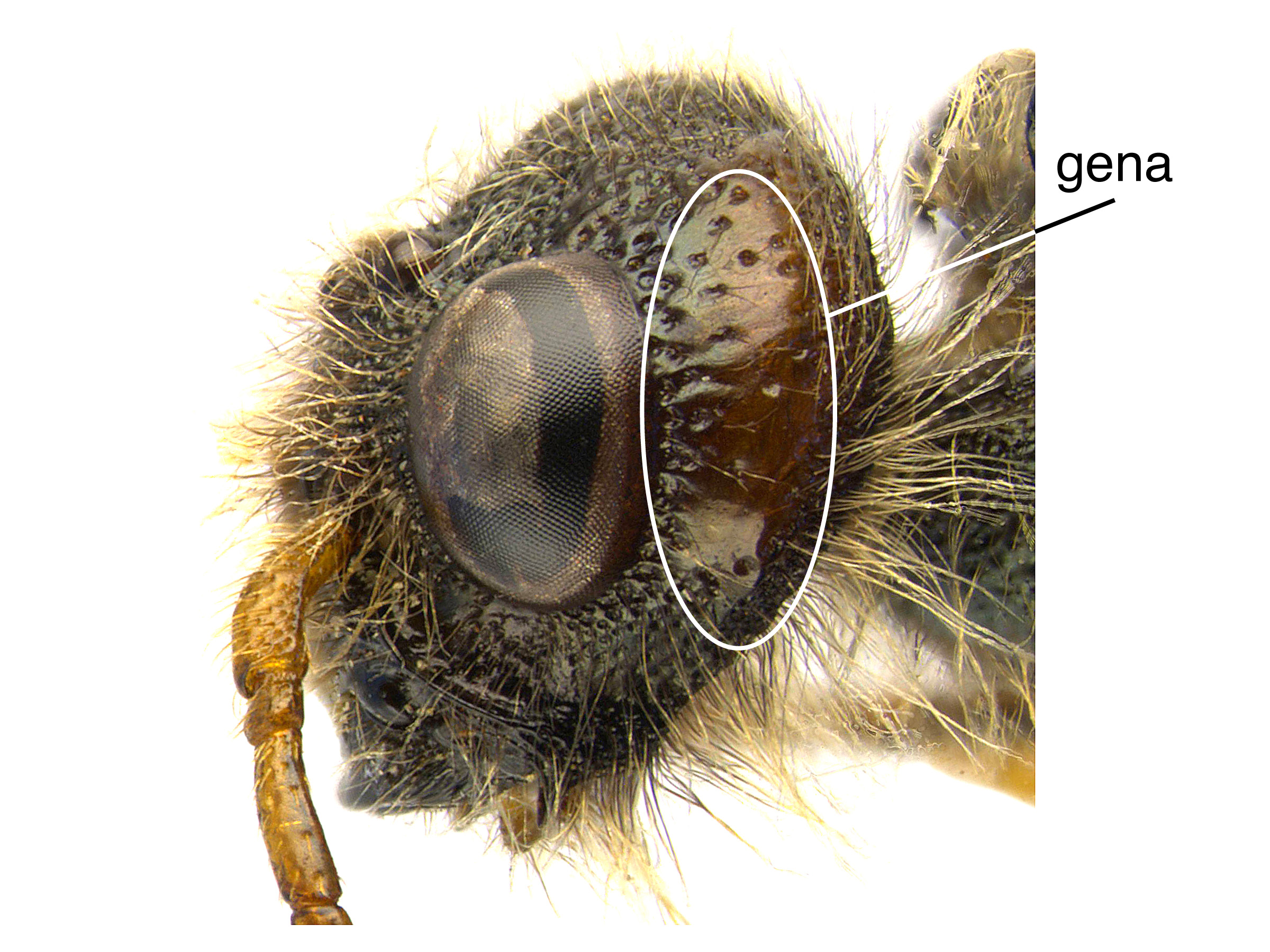 small, about 0.1–0.25 times size of laterallateral:
small, about 0.1–0.25 times size of laterallateral: scattered, about 2–10 pit diameters apart (Schiff et al. 2012Schiff et al. 2012:
scattered, about 2–10 pit diameters apart (Schiff et al. 2012Schiff et al. 2012: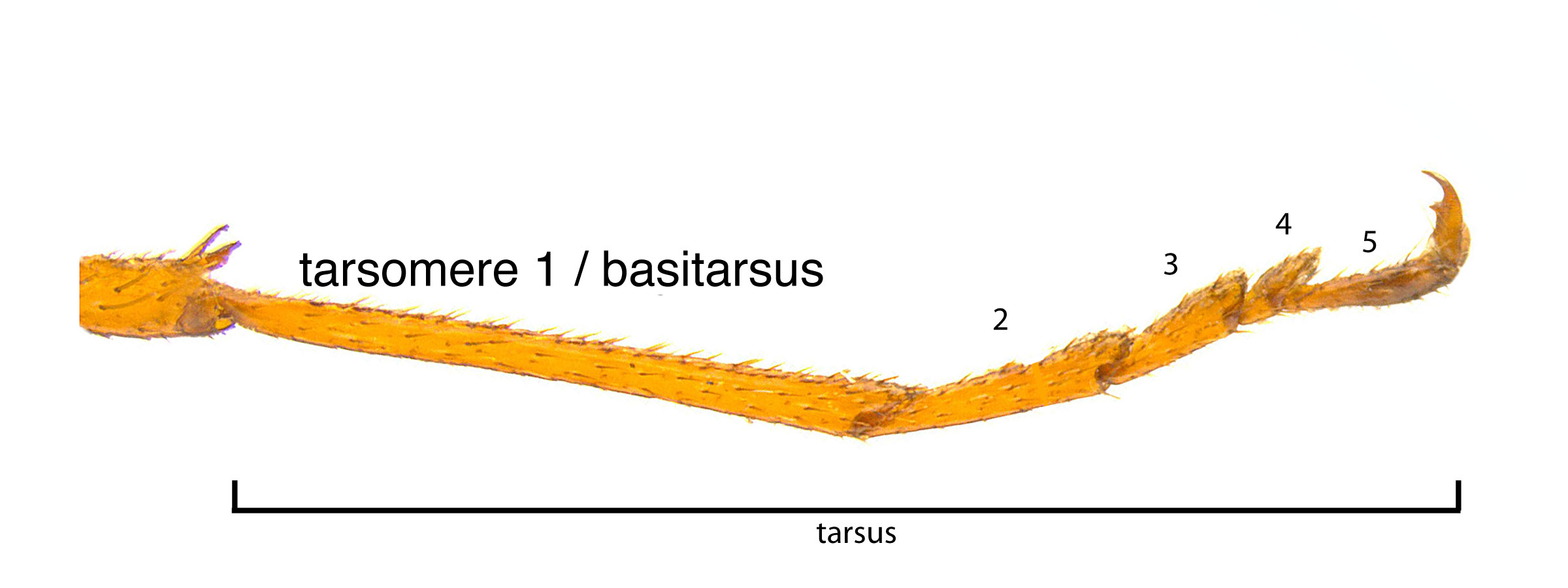 2–3.6 times as long as wide (Schiff et al. 2012Schiff et al. 2012:
2–3.6 times as long as wide (Schiff et al. 2012Schiff et al. 2012: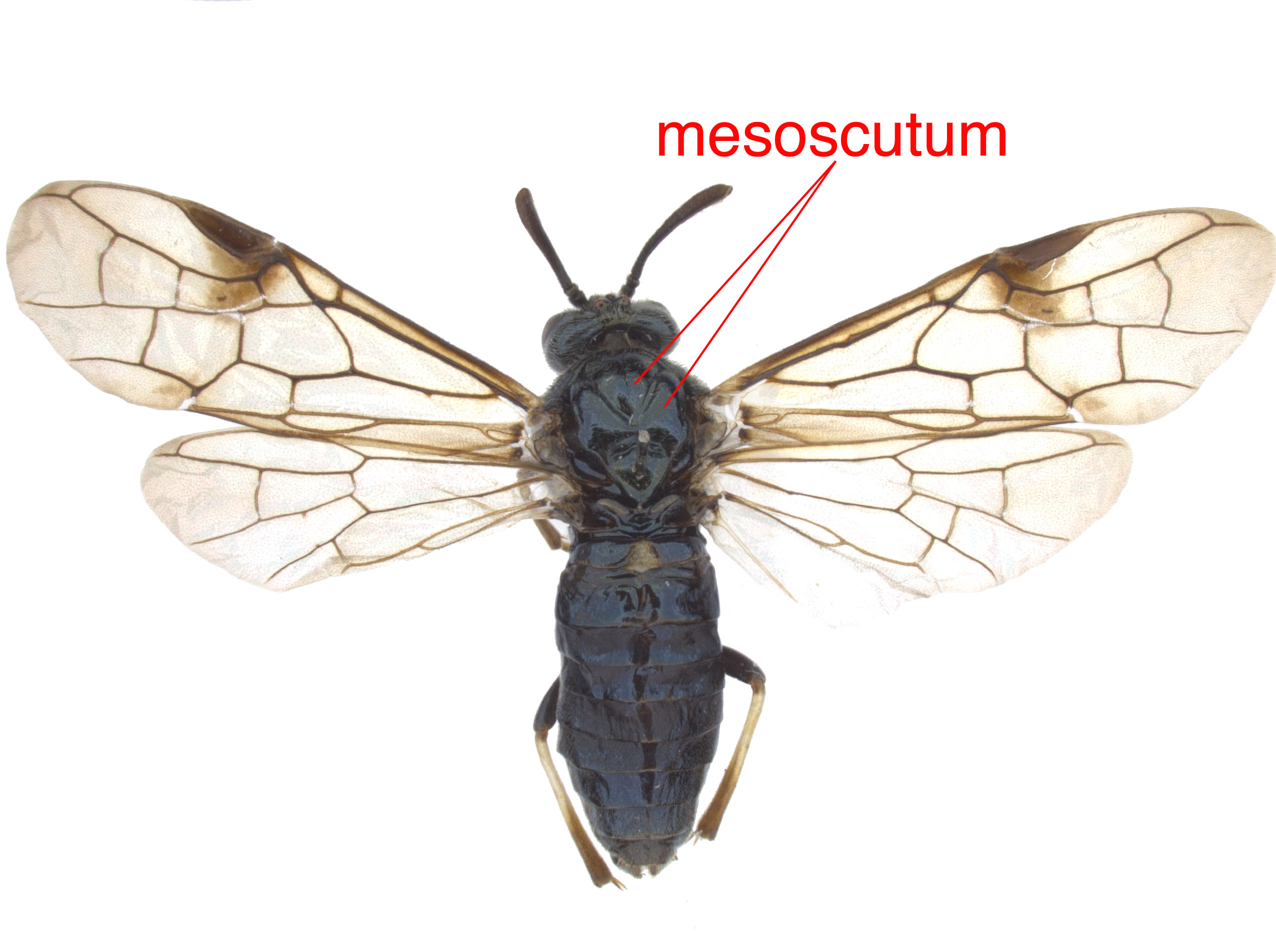 pits with raised margins forming a net-like pattern (Schiff et al. 2012Schiff et al. 2012:
pits with raised margins forming a net-like pattern (Schiff et al. 2012Schiff et al. 2012: with pulvilluspulvillus:
with pulvilluspulvillus: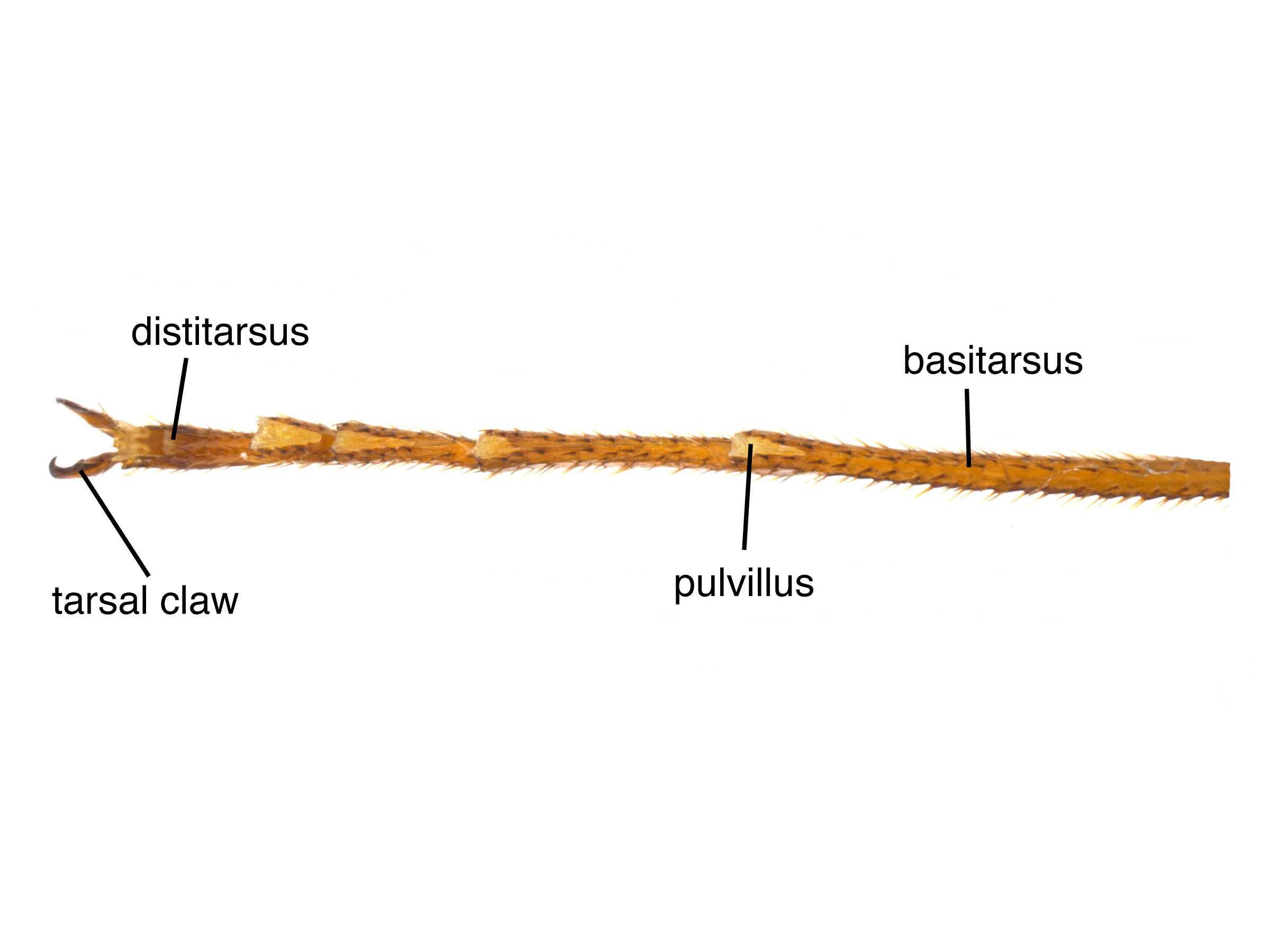 0.8 times length of tarsomeretarsomere:
0.8 times length of tarsomeretarsomere: (Schiff et al. 2012Schiff et al. 2012:
(Schiff et al. 2012Schiff et al. 2012: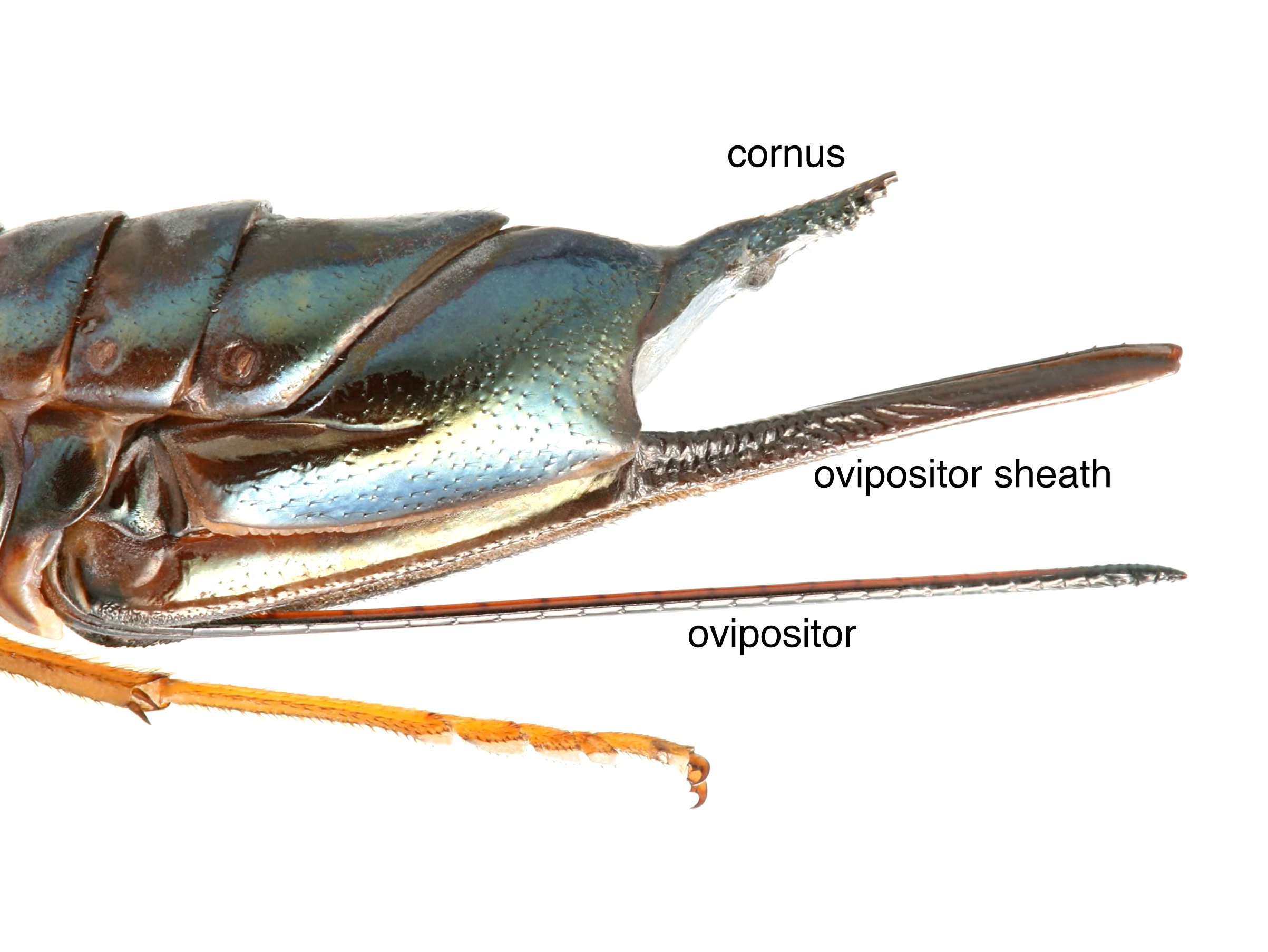 pits absent near basebase:
pits absent near basebase: pits near middle 0–0.14 times length of annulusannulus:
pits near middle 0–0.14 times length of annulusannulus: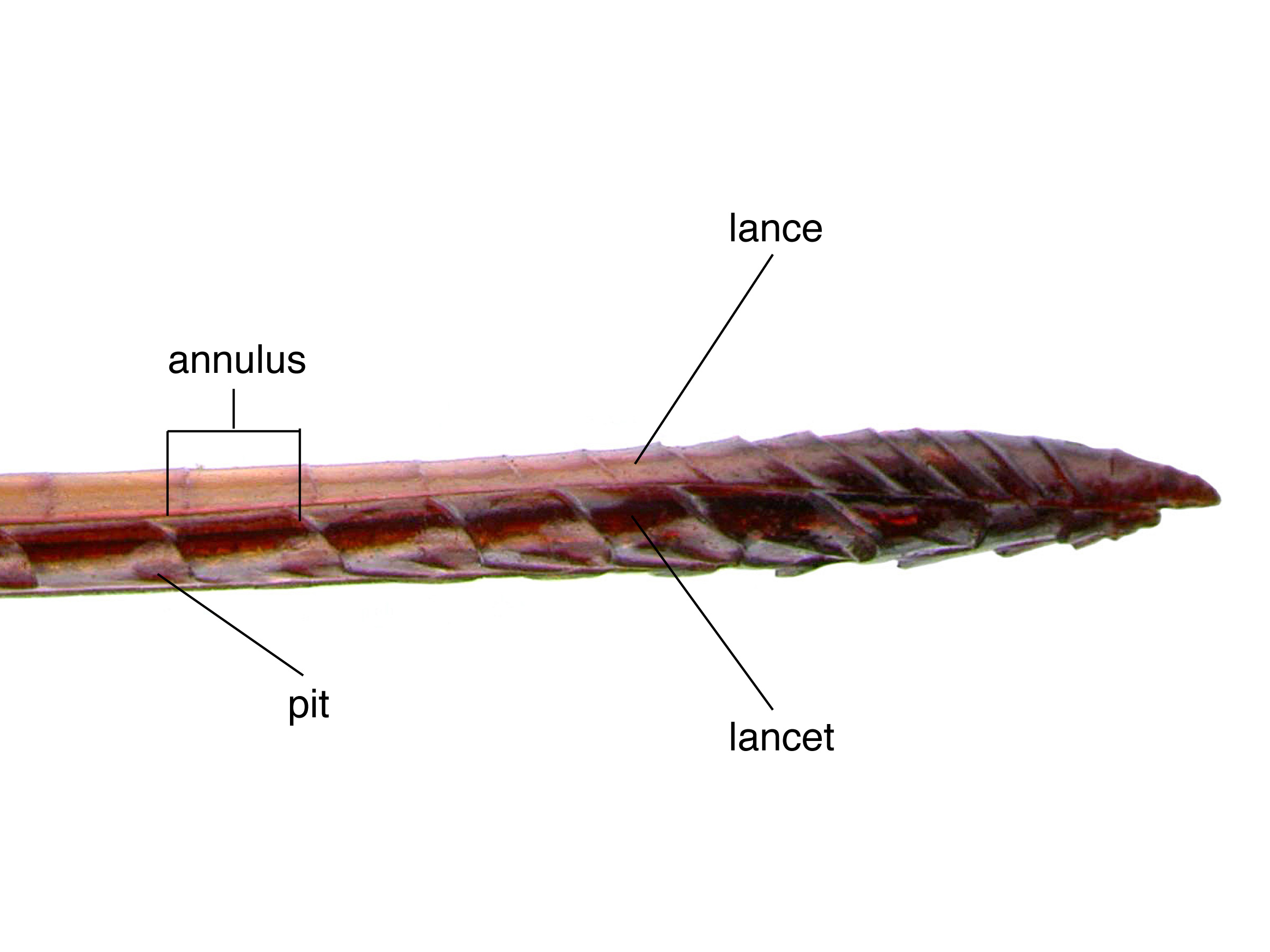 (Schiff et al. 2012Schiff et al. 2012:
(Schiff et al. 2012Schiff et al. 2012: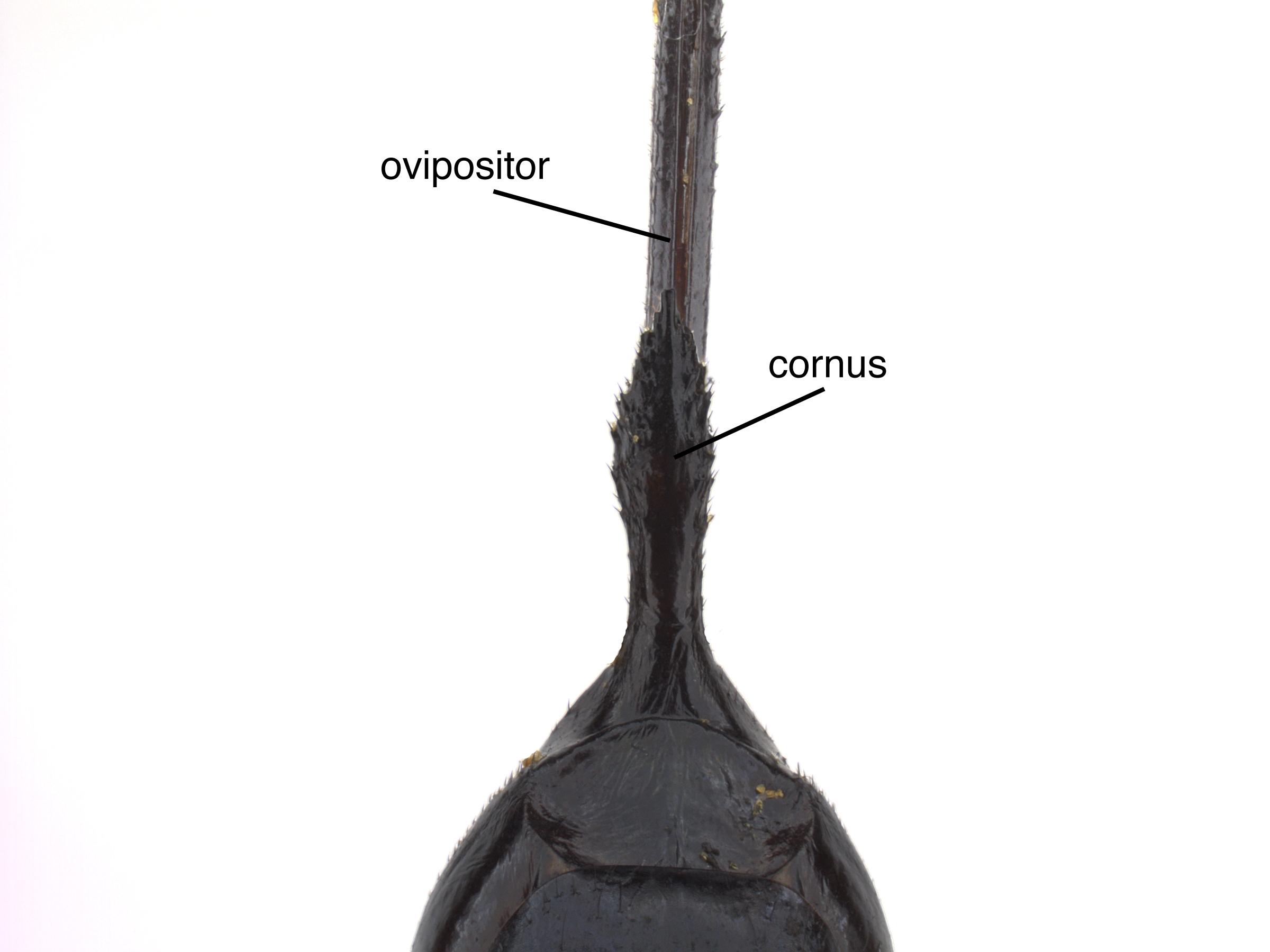 long, about twice as long as wide (Schiff et al. 2012Schiff et al. 2012:
long, about twice as long as wide (Schiff et al. 2012Schiff et al. 2012:Males:
 completely reddish-brown (Schiff et al. 2012Schiff et al. 2012:
completely reddish-brown (Schiff et al. 2012Schiff et al. 2012: dark blue with metallic reflections (Schiff et al. 2012Schiff et al. 2012:
dark blue with metallic reflections (Schiff et al. 2012Schiff et al. 2012: black with narrow band of reddish-brown at the basebase:
black with narrow band of reddish-brown at the basebase: pits with projections, margins forming a net-like pattern (Schiff et al. 2012Schiff et al. 2012:
pits with projections, margins forming a net-like pattern (Schiff et al. 2012Schiff et al. 2012: pits generally 1–3 diameters apart posterodorsallyposterodorsal:
pits generally 1–3 diameters apart posterodorsallyposterodorsal: with tergites 1–2 or 1–3 black, remaining tergites reddish-brown (Schiff et al. 2012Schiff et al. 2012:
with tergites 1–2 or 1–3 black, remaining tergites reddish-brown (Schiff et al. 2012Schiff et al. 2012:Sirex abietinus females can be distinguished from S. cyaneus by the missing pits at the basebase:
the beginning or most proximal area of any structure
of the ovipositorovipositor:
the female organ that deposits eggs and is used to drill into plant tissue, located at the apex of the abdomen, made up of the lance and lancet
 and the long cornuscornus:
and the long cornuscornus:
a pointed horn-like process on the apical end of the abdomen in Siricidae sawflies; on tergite 10 in females, sternite 9 in males
 , and from S. californicus and S. nitidus by the ovipositorovipositor:
, and from S. californicus and S. nitidus by the ovipositorovipositor:
the female organ that deposits eggs and is used to drill into plant tissue, located at the apex of the abdomen, made up of the lance and lancet
 pit length and the relative length of the pulvilluspulvillus:
pit length and the relative length of the pulvilluspulvillus:
soft pads used for surface adhesion, located in sawflies on the first 4 segments of the tarsus
 on the second hind tarsomeretarsomere:
on the second hind tarsomeretarsomere:
a segment of the tarsus
 . The same set of characters can distinguish S. abietinus from S. noctilio, although the two species do not currently have overlapping ranges (Schiff et al. 2012Schiff et al. 2012:
. The same set of characters can distinguish S. abietinus from S. noctilio, although the two species do not currently have overlapping ranges (Schiff et al. 2012Schiff et al. 2012:
Schiff NM, Goulet H, Smith DR, Boudreault C, Wilson AD, and Scheffler BE. 2012. Siricidae (Hymenoptera: Symphyta: Siricoidea) of the Western Hemisphere. Canadian Journal of Arthropod Identification 21: 1-305.).
none recorded
Sirex species feed on trees of Pinaceae and Cupressaceae. Sirex abietinus is recorded on Pinaceae species Abies amabilis (Pacific silver fir), Abies concolor (white fir), Abies lasiocarpa (subalpine fir), Picea engelmannii (Engelmann spruce), Picea glauca (white spruce), Picea sitchensis (Sitka spruce), and Tsuga heterophylla (western hemlock). The majority of specimens reared (83%) have been on Abies spp. (fir) (Schiff et al. 2012Schiff et al. 2012:
Schiff NM, Goulet H, Smith DR, Boudreault C, Wilson AD, and Scheffler BE. 2012. Siricidae (Hymenoptera: Symphyta: Siricoidea) of the Western Hemisphere. Canadian Journal of Arthropod Identification 21: 1-305.).
Female Sirex harbor symbiotic basidiomycete fungus in abdominal glands called mycangia. During oviposition, the site is inoculated with the fungus, which begins to decompose the surrounding wood. LarvaeLarva:
the immature stage of holometabolous insects
 feed on the fungus, boring galleries through the wood while they feed (Johnson 1930Johnson 1930:
feed on the fungus, boring galleries through the wood while they feed (Johnson 1930Johnson 1930:
Johnson CW. 1930. On the variation and abundance of Sirex nitidus Harris. Psyche 37 (3): 281-282. https://doi.org/10.1155/1930/62786, Schiff et al. 2012Schiff et al. 2012:
Schiff NM, Goulet H, Smith DR, Boudreault C, Wilson AD, and Scheffler BE. 2012. Siricidae (Hymenoptera: Symphyta: Siricoidea) of the Western Hemisphere. Canadian Journal of Arthropod Identification 21: 1-305.). It is unknown what species of fungus is harbored by the mycangia of S. abietinus; Amylostereum areolatum and A. chailletii are associated with other NearcticNearctic:
describing the region of the Northern Hemisphere that includes North America south through northern Mexico
 Sirex (Hajek et al. 2013Hajek et al. 2013:
Sirex (Hajek et al. 2013Hajek et al. 2013:
Hajek AE, Nielsen C, Kepler RM, Long SJ, and Castrillo L. 2013. Fidelity among Sirex woodwasps and their fungal symbionts. Microbial Ecology 65: 753-762. https://doi.org/10.1007/s00248-013-0218-z).
Larvae are creamy white and grub-like in appearance with a dark head capsule. As with adults, larvaelarva:
the immature stage of holometabolous insects
 possess a short dorsaldorsal:
possess a short dorsaldorsal:
of or on the top surface of the body or structure
horn on the posterior end of the body. The larvaelarva:
the immature stage of holometabolous insects
 bore galleries into wood, feeding until pupation and subsequent emergence. Throughout this process, the larvaelarva:
bore galleries into wood, feeding until pupation and subsequent emergence. Throughout this process, the larvaelarva:
the immature stage of holometabolous insects
 use their horn to pack the tunnel behind them with sawdust. Emergence holes are perfectly circular. The fungal symbiont is carried in specialized organs in female larvaelarva:
use their horn to pack the tunnel behind them with sawdust. Emergence holes are perfectly circular. The fungal symbiont is carried in specialized organs in female larvaelarva:
the immature stage of holometabolous insects
 that develop into the mycangia after metamorphosis (Schiff et al. 2012Schiff et al. 2012:
that develop into the mycangia after metamorphosis (Schiff et al. 2012Schiff et al. 2012:
Schiff NM, Goulet H, Smith DR, Boudreault C, Wilson AD, and Scheffler BE. 2012. Siricidae (Hymenoptera: Symphyta: Siricoidea) of the Western Hemisphere. Canadian Journal of Arthropod Identification 21: 1-305.).
The documented flight period of S. abietinus is late July through mid-September, with most collections in August (Schiff et al. 2012Schiff et al. 2012:
Schiff NM, Goulet H, Smith DR, Boudreault C, Wilson AD, and Scheffler BE. 2012. Siricidae (Hymenoptera: Symphyta: Siricoidea) of the Western Hemisphere. Canadian Journal of Arthropod Identification 21: 1-305.). There is some evidence that preferred hosts have sustained damage from drought-related stress, weather, or other insect infestations (Burnip et al. 2010Burnip et al. 2010:
Burnip GM, Voice D, and Brockerhoff EG. 2010. Interceptions and incursions of exotic Sirex species and other siricids (Hymenoptera: Siricidae). New Zealand Journal of Forestry Science 40: 133-140.).
World: North America. This species has been intercepted at ports in England and New Zealand (Schiff et al. 2012Schiff et al. 2012:
Schiff NM, Goulet H, Smith DR, Boudreault C, Wilson AD, and Scheffler BE. 2012. Siricidae (Hymenoptera: Symphyta: Siricoidea) of the Western Hemisphere. Canadian Journal of Arthropod Identification 21: 1-305.).
North America: The range of S. abietinus is west of the Rocky Mountains to the Pacific ocean, extending as far north as the Yukon Territory, and south to California, Utah, and Colorado (Schiff et al. 2012Schiff et al. 2012:
Schiff NM, Goulet H, Smith DR, Boudreault C, Wilson AD, and Scheffler BE. 2012. Siricidae (Hymenoptera: Symphyta: Siricoidea) of the Western Hemisphere. Canadian Journal of Arthropod Identification 21: 1-305.).
Map data from Washington State Department of Agriculture Entomology Collection.
Details about data used for maps can be found here.